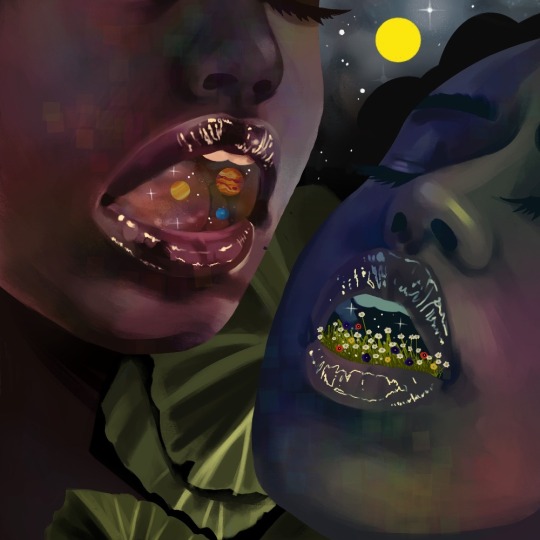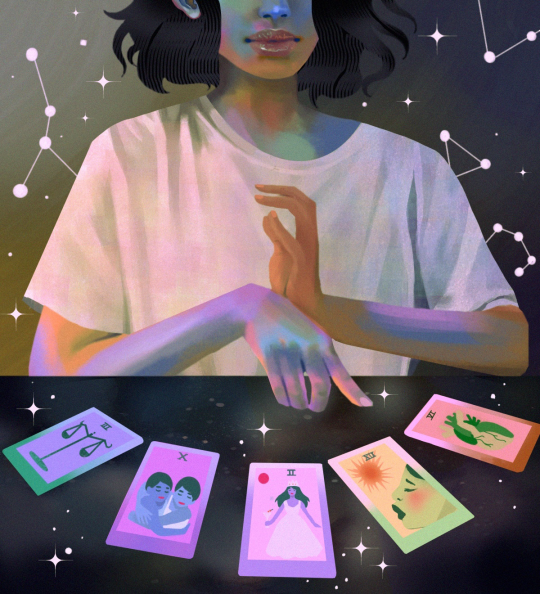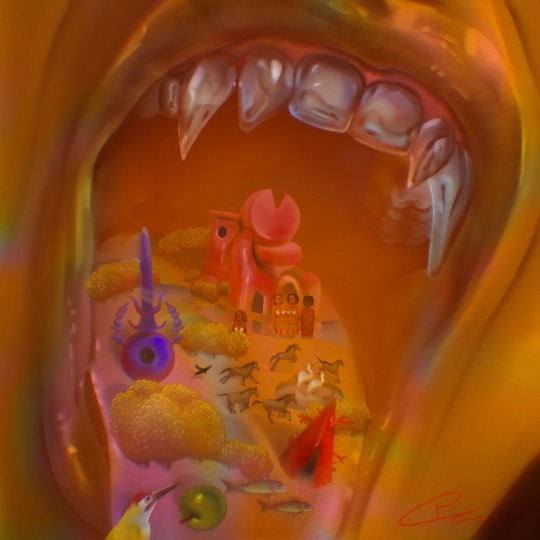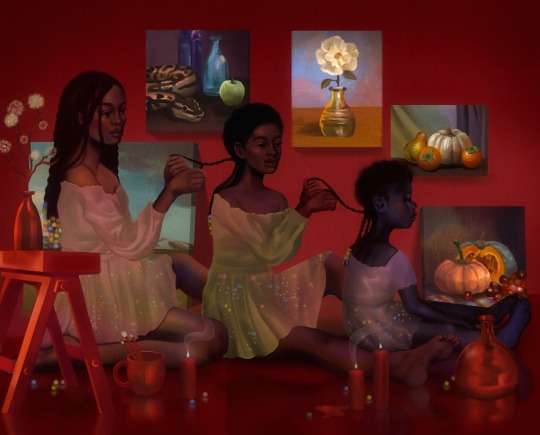#cienna smith
Text

Exhale
#cienna smith#ciennasmith#digital art#digital illustration#my art#blackartwork#black woman art#artists on tumblr
0 notes
Photo

Sensory Overload, by Cienna Smith.
10 notes
·
View notes
Photo

The Fault, Dear Reader, Is Not in Our Stars
Mental health care is pricey and inaccessible. Online astrology is rising to take its place
As many young people have discovered, the right therapist can be hard to find. There are often wait-lists, and after each session, there’s always a bill. It takes a lot of time—and money—to build trust with a professional and make progress as a person. Fast spirituality, on the other hand, can be instantaneous, prescriptive, soothing, and free. Is it really so surprising that more and more people treat their zodiac signs as diagnoses, replacing the long, difficult path of professional therapy with instructions from the cosmos?
Read more at thewalrus.ca.
Illustration by Cienna Smith (ciennasmith.com).
#Health#Mental health#Therapy#Astrology#Tarot#Horoscope#Cosmic#In Other Worlds: A Space Exploration#Illustration#Cienna Smith#Carly Lewis
4 notes
·
View notes
Text
CAFC: Arthrex Inoculated IPRs that had not yet reached Final Written Decision
Caterpillar Paving Products Inc. v. Wirtgen America, Inc. (Fed. Cir. 2020)
In 2018, Wirtgen petitioned the USPTO Director to institute an inter partes review (IPR) against Caterpillar’s US9045871 (paving machine). The PTO initiated the IPR, and eventually concluded that the challenged claims (as well as proposed substitute claims) were all unpatentable.
On appeal, Caterpillar asked the court to vacate and remand the decision for a new-hearing with a new-panel – citing Arthrex, Inc. v. Smith & Nephew, Inc., 941 F.3d 1320 (Fed. Cir. 2019). However, the court has refused:
Unlike in prior cases in which this court has recently vacated and remanded, Arthrex issued before the Board’s final written decision in this case.
The theory of Arthrex is that the court’s cancellation of PTAB judge job security instantly cured the Constitutional appointments problem (making them inferior officers rather than principal offiers). Here, the Arthrex cure (Oct 2019) came just before the Caterpillar final judgment (Nov 2019). Caterpillar argued that it suffered under “a year’s worth of constitutional violations.” On appeal, however, the Federal Circuit ruled that the inoculation was complete against any IPR that had not yet reached final judgement.
Caterpillar, coupled with Cienna Corp., look to place a hard limit on the number of cases requiring new paneling following Arthrex.
Now Precedential: IPR Petitioner who Waived Arthrex issue cannot Raise it on Appeal after Losing the IPR
CAFC: Arthrex Inoculated IPRs that had not yet reached Final Written Decision published first on https://immigrationlawyerto.tumblr.com/
0 notes
Text
Episode 167
Heroes in Crisis 2, JLD/WW, Justice League/Aquaman Drowned Earth, DC/Hannah Barbera, Terrifics Annual, Hex Wives, Wytches: Bad Egg Special, Avengers Halloween Special, Spider-Force, Vault of Spiders, What If: Magik, X-Men Black - Emma Frost, Jessica Jones: Blindspot, Edgar Allan Poe’s Snifter of Terror, Midnight Mystery, Planet of the Apes: Time of Man
Reviews: Sex Death Revolution, Spidey 2099 v2, Spider-Man game, Doctor Who s11e05, Bohemian Rhapsody, Doc Aphra v1, WW Earth One v2
News: Bucky/Falcon streaming show, Penny Dreadful spin-off, Who Christmas, Old Man Quill, DC Crossover - Flash with Italian superhero universe, Walking Dead movie trilogy, Obi Wan is Black Mask, Buffy reboot
Comics Details:
Heroes in Crisis 2 by Tom King, Clay Mann, Travis Moore, Tomeu Morey, Arif Prianto
Justice League Dark/Wonder Woman: The Witching Hour by James Tynion IV, Fernando Blanco, Miguel Mendonca, Jesus Merino, Romulo Fajardo Jr
Justice League/Aquaman: Drowned Earth by James Tynion IV, Howard Porter, Hi-Fi
Batman: Secret Files by Tom King, Mikel Janin, Jordie Bellaire, Ram V, Jorge Fornes, Matt Wilson, Cheryl Lynn Eaton, Elena Casagrande, Jill Thompson, Trish Mulvihill, Tom Taylor, Brad Walker, Drew Hennessy
Deathstroke/Yogi Bear by Frank Tieri, Mark Texeira, Jeromy Cox, JM DeMatteis, Tom Mandrake, Hi-Fi
Green Lantern/Huckleberry Hound by Mark Russell, Rick Leonardi, Dan Green, Ande Parks, Steve Buccellato, JM DeMatteis, Tom Mandrake, Hi-Fi
Nightwing/Magilla Gorilla by Heath Corson, Tom Derenick, Tom Grummett, Andy Owens, Cam Smith, Pete Pantazis, JM DeMatteis, Tom Mandrake, Hi-Fi
Superman/Top Cat by Dan DiDio, Shane Davis, Michelle Delecki, Dean White, JM DeMatteis, Tom Mandrake, Hi-Fi
Hex Wives 1 by Ben Acker, Mirka Andolfo, Marissa Louise
Terrifics Annual by Gene Luen Yang, Joe Bennett, Richard Friend, Scott Hanna, Matt Santorelli, Mark Russell, Doc Shaner, Nathan Fairbairn, James Asmus, Jose Luis, Jordi Tarragona, Hi-Fi
Avengers Halloween Special by Rob Fee, Eoin Marron, Michael Spicer, Gerry Duggan, Laura Braga, Arif Prianto, Jen Soska, Sylvia Soska, Jonas Scharf, Jordan Boyd, Jay Baruchel, Luca Pizzari, Robbie Thompson, Bob Quinn
Spider-Force 1 by Chris Priest, Paulo Siquiera, Oren Junior, Craig Yeung, Guru eFX
Vault of Spiders 1 by Jed MacKay, Scott Koblish, Andres Mossa, Cullen Bunn, Javier Pulido, Muntsa Vicente, Sheldon Vella, Nilah Magruder, Alberto Alburquerque, James Asmus, Juen Gedeon
What If: Magik by Leah Williams, Filipe Andrade, Chris O’Halloran
X-Men Black - Emma Frost by Leah Williams, Chris Bachalo, Wayne Faucher, John Livesay, Jaime Mendoza, Tim Townsend, Al Vey, Dan Brown, Antonio Fabela, Chris Lopez
Jessica Jones: Blindspot by Kelly Thompson, Mattia de Iulis, Marcio Takara, Rachelle Rosenberg
Wytches: Bad Egg by Scott Snyder, Jock, Matt Hollingsworth
Edgar Allan Poe’s Snifter of Terror 1 by Tom Peyer, Fred Harper, Michael Garland, Mark Russell, Peter Snejberg, Cienna Madrid, Carly Wright, Hunt Emerson
Midnight Mystery 1 by Bernie Gonzalez
Planet of the Apes: The Time of Man 1 by Dan Abnett, Phillip Kennedy Johnson
Comics Countdown, 31 Oct 2018:
Wytches: Bad Egg Halloween Special by
Justice League Dark/Wonder Woman: The Witching Hour by James Tynion IV, Fernando Blanco, Miguel Mendonca, Jesus Merino, Romulo Fajardo Jr
Jessica Jones: Blindspot by Kelly Thompson, Mattia de Iulis, Marcio Takara, Rachelle Rosenberg
Tony Stark: Iron Man 5 by Dan Slott, Max Dunbar, Gang-Hyuk Lim, Dono Sanchez-Almara
Nancy Drew 5 by Kelly Thompson, Jenn St-Onge, Triona Farrell
West Coast Avengers 3 by Kelly Thompson, Stefano Caselli, Triona Farrell
Fence 11 by CS Pascat, Johanna the Mad, Joana Lafuente
Ice Cream Man 8 by W Maxwell Prince, Martin Morazzo, Chris O’Halloran
Infinity Wars: Iron Hammer 2 by Al Ewing, Ramon Rosanas, Jason Keith
Spider-Force 1 by Chris Priest, Paulo Siquiera, Oren Junior, Craig Yeung, Guru eFX
Check out this episode!
0 notes
Text
Camp & Androgyny: The Story of Queer Culture Going Mainstream
Group #1: Grace Jacobsen, Cienna Page, and Ryan Williams
Camp and androgyny are two aspects of queer culture that have broken into the mainstream. These aesthetic choices emphasize the extremes of gender bending or genderfuck fashion and campy fashion. Both were born out of the queer community, particularly in drag culture in the 1960s. Campy queens were common and popular because they emphasized the aspect of queer culture that many did not want to take part in. Androgyny, on the other hand, is a blending of the two genders. According to Andrews, Cook and Martin (2016), “Androgyny was described as individuals possessing a wide repertoire of characteristics that were masculine and feminine - assertive and yielding, and instrumental and expressive…” (p. 593) Both became influential styles although, androgyny had been practiced long before camp came into the mainstream. WIth artists like Elton John, Prince, David Bowie, Annie Lennox, Lady Gaga and Janelle Monáe. But what have these artists also brought to the table other than widespread recognition of camp and androgyny, as well as LGBT platforms. They have brought the idea that queer people are defined specifically as camp or androgynous, but they are never “normal” people. This leads to a stereotype that many queer people have been fighting for decades; not every gay man wants to be or acts like a drag queen or campy, and not every lesbian wants to be androgynous and be manly. One could also argue that straight, cisgender artists have used elements of camp and androgyny to further their career. They use them as tools to generate buzz around their music, performances and have benefited from the increase media exposure.
Movie cover for the 25th anniversary of Jon Waters' Pink Flamingos starring Devine
Image Source: https://noma.org/event/john-waters-film-festival-pink-flamingos/
The history of camp and androgyny start off on very different paths but both come from queered cultures. It has been speculated that the word "camp" comes from the French word “se camper”, or to flaunt, which may explain the connotation of flaunting one's queerness. The camp aesthetic and style can be recognized as far back as the early eighteenth century, growing alongside queer subcultures rising within western European cities. The heteronormative melodrama surrounding classic Hollywood became a breeding ground for members of the “cult of camp”, or the camp fanbase.
Actresses like Joan Crawford, with her larger than life personality and acting prowess, Mae West, with her crude humor partnered with the dolled up vision of classic Hollywood, and Judy Garland, with her exaggerated mannerisms and style, were massive influences to the camp aesthetic. This aesthetic includes more than just the clothes, but an attitude and a way one presents themselves, almost an identity. Actresses like Mae West, Judy Garland and Joan Crawford built their images upon the foundation of camp. Gay men specifically celebrated “the style and bitchiness” of these actresses and, as otherwise heterosexual women, they became gay icons because of their queer personalities till this very day.
But actresses weren’t the only people capitalizing off the cult of camp. The 1960s brought about countless filmmakers who employed the ideas of camp in film, including experimental filmmakers such as Kenneth Anger, Jack Smith, and Andy Warhol. Their queered films, like Lucifer Rising [1973], Flaming Creatures [1963], Blowjob [1963], became infamous among an ever growing audience and came to inspire the legendary filmmaker John Waters. His character Divine, a truly camp drag queen famous for her exaggerated makeup and huge personality, starred in countless films of her own including Pink Flamingos [1972], Female Trouble [1974], Polyester [1981], and Hairspray [1988]. All of these films, though from different times and directors, all captivate a similar theme of dramatization. These directors all employed the camp aesthetics in their films in different ways but all interpretations are camp: a sensibility and style based in exaggeration and theatrics.
American actress Marlene Dietrich wearing male inspired tuxedos
Image Source:
http://clothedchameleon.blogspot.com/2012/01/pass-me-some-of-that-androgyny.html
Androgyny exists on the other side of the spectrum, almost completely opposite to the drama that is camp. Androgyny began as a fashion statement before it began presenting as gender later into the 20th century. It originally began as feminist movement with few women in power mixing masculine pieces with gowns and corsets. It was seen as a powerful statement and, after the high feminine fashion of the Victorian era, in the 1920s and brought a very queer movement that involved women taking on more boyish appearances.
The desired female body in the 1920s was thin, flat, and masculine, the same way people look at thick and curvy bodies today. The era brought tuxedos, short haircuts, fedoras, and other traditionally male accessories and clothing to the women's fashion realm. Women even went as far as to bind their chests with bandages to achieve flatter chests. But women were not alone in this venture.
The counterculture movement brought traditionally feminine fashion to the men’s world like long hair, bright colors, flowing clothing, and prints, while women wore bell bottom pants to achieve a straight silhouette and shoulder padding in suit jackets to look broader and more commanding. The idea of mixing the two gender presentations was desirable and even mainstream and normative while being very queer. Queer and straight people alike participated in the phenomenon and it has yet to slow ever since.
Today, fashion presents androgyny as more avant-garde, even earning a category as “non-binary/gender bending” over the past year at Paris Fashion Week. However, many reclaim it as a perfectly efficient style or even as a gender orientation. As a concept, androgyny has always been the implication of not being completely male nor female as it lays on a spectrum in between. This fluidity of the fashion has allowed people who don’t fit the two gender binaries to identify on a spectrum with a label that makes them more comfortable. Even though it did not start out as gender presentation and even heteronormative, androgyny has certainly been embraced as queer culture for be gender bending.
David Bowie, in monochromatic tones, seductively engages the camera while smoking a cigarette
Image Source: https://www.huffingtonpost.com/entry/david-bowie-mick-rock_us_55f722d6e4b063ecbfa5397b
David Bowie. He is seen as the king of camp and androgyny. His style and aesthetic have been influential to other artists since the 1960s, and his widespread success has been credited to some acceptance of queer individuals. Although Bowie has described himself as bisexual, it was noted that this was more of an experimentation phase, rather than his actual identity. He was married twice, has had children, and rarely spoke about his private sex life. His most famous persona would have to be Ziggy Stardust, a character that is recognized as androgynous and blurring the lines of gender. The reader or listener does not truly know what gender the character is, and it is left up to the imagination.
Prince seductively posing for the camera
Image Source: http://www.theelitesng.com/in-fashion-prince-reigned-supreme-nudity-androgyny-and-the-color-purple/
Prince was known for two things: his musical ability and his fashion. From early on in his career, Prince pushed the boundaries and comfort level for many people. His over the top fashion choices, often complimented with heels, were used as tools to generate buzz around his music. One interesting fact was that Prince stated he only wore heels because women that it was sexy. Prince was a known womanizer who has had numerous affairs and fligns in Hollywood, notable examples being Shelia E., Carmen Electra, Kim Basinger, Madonna and many others. His use of androgyny and camp was started in the beginning of his career until around 2001 when he became a Jehovah’s Witness. From that point on he would distance himself from the sexually explicit material and costumes that had made him famous. Even though it is not part of our picture count, I will insert one of his most iconic fashion moments.
Prince performing at the 1991 MTV Video Awards wearing assless chaps
Image Source: https://giphy.com/gifs/prince-sexiest-9QIpjGhTcOTLO
Elton John performing in one of his many outlandish costumes
Image Source: https://www.pinterest.com/pin/455356212296065007/?lp=true
Out of all the artists that have used camp as an effective tool to further their career, Elton John is probably one of the most famous. The rocket man was known for his outlandish outfits and performance materials. His often bedazzled, colorful and campy costumes would garner attention from around the world. Unlike the previous male entries on this list, Elton John is in fact gay. His sexuality and the association between that and his outfits may have a contributing factor as to why gay men have to live with this.
Justin Johnson and his real estate agent, Phillip, embrace upon learning that Justin will be a homeowner (Dancing Queen – Season 1 Episode 2 Man, I Feel Like a Woman)
Source: https://www.netflix.com/watch/80198436?trackId=200257859
The Netflix original series “Dancing Queen” is a reality series which follows the life and career of Justin Johnson, known by his stage name Alyssa Edwards, an iconic drag performer most recognized for her multiple appearances on the Emmy-winning television show, RuPaul’s Drag Race. Apart from the fame of Alyssa Edwards, Johnston, too, is a successful business person and choreographer. It is in this unscripted frenzy, where Netflix subscribers are thrust into the world of dance, drag, and drama. On its surface, “Dancing Queen” presents itself as refreshing and sunny in disposition. (D’Addario, 2018) However, once below the surface, this sunny series is really just a perfect example of the commodification of (queer) camp culture. Which brings into question the issues which surrounds the commodification of marginalized groups for the benefit of the larger, hegemonic media landscape.
To give context and understanding, the above image depicts Justin Johnson, a queer individual, pursuing the general American, neoliberal dream of home ownership. Johnson is quite literally embracing, as depicted by the real estate agent, capitalistic and neoliberal dominant values. Where, then, the returned embrace of the real estate agent can be interpreted as a hegemonic nod to “it doesn’t matter your identity – race, gender, sexual identity or the like – so long as you have the money you will be taken seriously.” Johnson now certainly has the money to be taken seriously. It is here where we see the obvious and problematic nature of the commodification of (queer) camp culture as seen in “Dancing Queen.” For, regardless of true support or inclusivity, if there are profits to be had the corporate elite will come running – whether that be in entertainment media or real estate. It is in this commodification of queer stereotypes as seen through the lens of Alyssa Edwards and Justin Johnson in “Dancing Queen” which “demonstrates the hegemonic nature of mass culture and the justification of exploitation through tolerance.” (Yaksich, 2005)
Image A: The feminine, Janelle Monáe, and masculine, Janelle Monáe, sitting upon the same couch.
Image Source: Source: https://www.youtube.com/watch?v=tGRzz0oqgUE
Image B: In her music video, “Make Me Feel,” the androgynous figure Janelle Monae assumes an assertive stance over her female partner, while simultaneously assuming a position of submissiveness with her male partner.
Source: https://www.youtube.com/watch?v=tGRzz0oqgUE
Janelle Monáe, widely recognized for her androgyny, appears in both feminine and masculine form in her 2018 music video “Make Me Feel.” Sitting poised on the arm of a couch and clothed in more traditionally feminine dress, Monáe looks down upon her own self laid back in what can only be described as more traditionally masculine dress. Here the masculine and the feminine collide in a rather nuanced moment of androgyny (Image A). A moment also played out in words as Monáe sings, “Powerful with a little bit of tender.” (Monáe, 2018) Two mutually opposed traits existing in one form. Though, as the music video progresses, Monáe’s androgynous theatricality begins to stray from moderate atypical gender expression to something entirely problematic – Janelle Monáe’s androgyny in “Make Me Feel” is fundamentally “reasserting binary understandings of gender, sexuality, and heteronormativity. Hence, her androgynous performance isn’t necessarily truly fluid or queer.” (M. Fischer, personal communication, October 18, 2018) This reassertion of a negative kind can be seen in Image B. When with the woman, Monáe assumes a position of power. She approaches from the front and takes on a very assertive sexual stance. When with the man, however, it is he who is in the position of power, not Monáe. She assumes a position of sexual submission, with her back to him as he stands above and behind her. Were this moment to have been truly queer, all sexual behaviors stereotypical of the heteronormative male/female dynamic would have been turned on its head. This was not the case. Instead, the dominant assumptions of the gender/sexual/ heteronormative binary were confirmed.
This is entirely problematic because, as a media text, Janelle Monáe’s “Make Me Feel” video holds the responsibility of helping to “influence our understandings of [differing] social identities … and [thereby shaping] how people view the world and what they understand – and perhaps misunderstand.” (Alberts, Nakayama, & Martin, 2016) The root of this problem lies in the fact that Janelle Monáe has distributed a falsely queer image in her music video which negatively misinforms peoples already pre-existing perceptions of queer identity.
The mainstream appropriation of camp and androgyny, as seen in the many examples outlined above, are, in reality, harmful because they perpetuate and (re)produce stereotypes about the queer community, reinforcing that queer identity is either exclusively theatrical or gender bending. On the one hand, such mainstream appropriation acts as a positive sign of queer acceptance into popular culture, however, it ultimately reinforces the mainstream (and often negative) stereotypes which surround queer identity characteristics. This can be seen in the historical emergence of camp and androgyny in cult film and avant-garde fashion, in the campy and/or androgynous musical performances of pop icons the likes of Prince, Elton John, or David Bowie, and in the contemporary examples of Janelle Monáe and Alyssa Edwards.
References
Alberts, J. K., Nakayama T. K., Martin, J. N., (2016) Human Communication in Society (4th Edition). New York, NY: Pearson.
Andrews, N.C.Z., Cook, R.E., Martin, C.L. (2016). Reviving androgyny: A modern day perspective on flexibility of gender identity and behavior. Sex Roles. 76. 592-603.
Camp. (n.d.). Retrieved October 17, 2018, from http://www.filmreference.com/encyclopedia/Academy-Awards-Crime-Films/Camp-THE-HISTORY-OF-CAMP.html
D'Addario, D. (2018, September 28). TV Review: Netflix's 'Dancing Queen'. Retrieved from https://variety.com/2018/tv/reviews/dancing-queen-review-netflix-alyssa-edwards-1202957290/
Monáe, J. (2018, February 22). Make Me Feel [Official Music Video] [Video file]. Retrieved from tGRzz0oqgUE
Townson, A., Sambrook, A., Lanning, C., Staker, J., Nuttall, B., Thomas, L., . . . Morgan Harries. (2016, February 05). A History of Androgyny in Fashion – The Oxford Student. Retrieved from https://www.oxfordstudent.com/2016/02/05/a-history-of-androgyny-in-fashion/
Yaksich, M. J., (2005). Consuming queer: The commodification of culture and its effects on social acceptance. Boston College Undergraduate Research Journal, 1, 1-12.
0 notes
Text

Speak Into Existence
#cienna smith#ciennasmith#digital art#digital illustration#my art#nyc#portrait#plants#artists on tumblr#black artist#black woman art
0 notes
Text




Morocco Studies 1-4 / 7
#moroccan style#moroccan cuisine#moroccanculture#morocco#digital art#artists on tumblr#black women art#art#cienna smith#ciennasmith#digital illustration#my art
0 notes
Text

Greenhouse
1 note
·
View note
Text

Artists ✨ by Cienna Smith
#blackartwork#black girl magic#braiding#digital aritst#digital art#digital illustration#my art#nyc#ciennasmith#cienna smith#red
1 note
·
View note